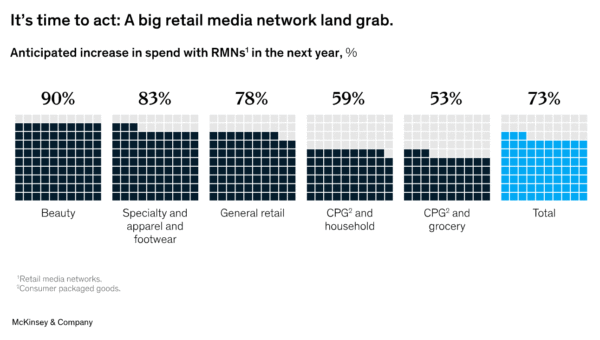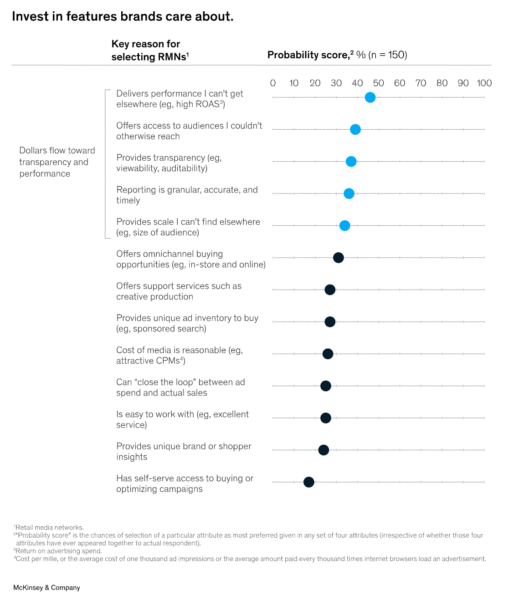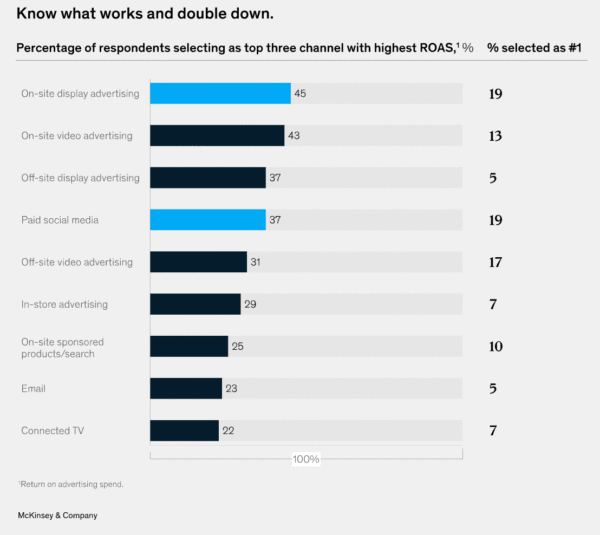Six secrets of unleashing the power of retail media
May 20, 2023

By Marc Brodherson, Jon Flugstad, Quentin George, and Jack Trotter
The $45 billion US retail media market is surging as retailers capitalize on the consumer shift to e-commerce while offering advertisers access to their unique audiences and data insights.1 Yet capturing advertising spending as a retail media network (RMN) is far from guaranteed. Advertisers are spoiled for choice across the RMN landscape, and the number of RMNs is growing by the day. The question is which RMNs will raise the bar to meet the needs of the sophisticated modern marketer.
We have previously busted myths about RMNs and looked at ways Europe’s retail media landscape can evolve.2 In this rapidly changing environment, our latest research on the US market provides a fresh view on the secrets of RMN success, including understanding the following:
- why demand for RMNs is increasing
- how advertisers are shopping around
- elements of a winning value proposition for RMNs
- what channels advertisers are prioritizing for RMN investment
- add-on features that drive a premium
- advertiser pain points to address
Even as companies cut marketing budgets and hunker down amid economic uncertainty, RMNs attract a larger share of the advertising pie. But retaining that spend and growing it further requires understanding and addressing what advertisers want and need before they go elsewhere.

Spending must be earned
Retail media may be a relatively new marketing channel for advertisers, but they’re already making early bets. Advertisers are splitting their business among an average of about four RMNs, and 27 percent have shifted spend from one RMN to another in the past year. The bottom line? If you don’t identify a winning proposition and deliver for advertisers, they’ll go elsewhere.

Providing differentiated value is a must
How do RMNs deliver a winning value proposition? The three most important factors for capturing, driving, and retaining advertising spend are providing superior performance, giving access to otherwise inaccessible audiences, and offering transparency. High-performing RMNs delivering these benefits can drive significant value for the media network (for example, double-digit year-over-year growth) and their advertisers (such as five to ten times the return on advertising spend). Less importance is placed on self-serve access, indicating advertisers prize performance over all else.

Dial up the right channels
Advertisers favor channels with the highest return on advertising spend: on-site display and video advertising. These channels outperform off-site advertising, and paid social media is also critical and cited by 19 percent of advertisers as their number-one choice (tied for highest with on-site display advertising).

Premium features drive spending
In addition to capturing shifting spend through differentiation and channel strategy, RMNs have another opportunity. Advertisers are willing to spend even more for added extras: 95 percent say they would pay a premium of more than 10 percent for extra features that help them make better-informed, timelier decisions about their marketing spend.

Identify and quickly address pervasive issues
RMNs who want to distinguish their offering and retain and grow their advertiser base can focus on solving advertisers’ biggest pain points. RMNs deliver a unique benefit in their proximity to the point of sale and their ability to close the loop. However, they can’t lose sight of nailing things that are table stakes for advertisers, such as transparent data sharing and reporting, reasonable media cost, customer insights, and scalable audiences.
Advertisers struggle most with retail media network data sharing and reporting.

About the author(s)
- Marc Brodherson is a senior partner in McKinsey’s New York office, Jon Flugstad is an associate partner in the Atlanta office, Quentin George is a partner in the Bay Area office, and Jack Trotter is a partner in the Denver office.
- The authors would like to thank Ana Bujosa, Isy Hatzidimitriou, Sri Reddy, and Aparna Srinath for their contributions to this article.



























